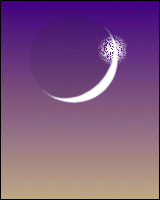H2G2 Observing the Moon
Created | Updated Feb 9, 2015
This is a test
H2G2 Astronomy Society
Moonwatching
Charting the uncharted backwaters of the Universe






| h2g2as Front Page | The main site page. |
| Moonwatching | The page for Lunartics. |
| h2g2as Q and A | Find the answers to many space related questions. |
| Astronomy Links | Find all the best astronomy links as well as links to local societies. |
| Heads Up | What's to see in the coming month. |
| Members Page | Meet the many researchers who have joined the h2g2as and join yourself. |
| Babe Among the Stars | Galaxy Babe's column in The Post. |
OBSERVING THE MOON

Lunar Phases for June
The following table lists the major lunar phases for the coming month. (June 2010)
| Last Quarter | New Moon | First Quarter | Full Moon |
|---|---|---|---|
| 4 June, 23:13 BST | 12 June, 12:15 BST | 19 June, 13:41 BST | 26 June, 21:33 BST |
.
The Moon, Day-by-Day
Day One
Looking for the first sliver of a crescent moon just after sunset and within 24 hours of new moon is a difficult and hazardous occupation. Usually it is lost in the twilight glow and haze of the Earth's atmosphere. It is possible to pick out the Moon at only 14.5 hours old. The Islamic calendar starts its month from the first sighting of the new moon and observers keep a look-out for the crescent to proclaim the start of each new month. For northern hemisphere observers the task is easiest during the spring months of March and April when the ecliptic plunges almost vertically down to the horizon. This means that the angular separation is vertical and the moon is at its highest above the horizon. Conversely from the southern hemisphere the same condition exists in September and October.
But a sub 24 hour moon is still difficult to find and should not be attempted until the Sun has completely set. Finding the Sun in the lens of a telescope or binoculars will magnify its effect and probably lead to irreparable damage to the eye's retina. It's best left to the expert. The crescent of a sub-24 hour moon will not be complete. The edge of the moon is rough, mountains and crater walls are seen side on and sunlight shines between the peaks and valleys appearing like a serrated edge.
Day Two
Now the crescent has become wider and because it is higher above the horizon at the point of sunset it is now much more easily identified. During the winter and spring months one of the most beautiful of the Moons phenomena is evident. The orb of the unlit portion of the moon can be seen. This is possible because sunlight is reflected from the Earth to the Moon and back again to Earth. This is twice reflected sunlight and is known by the equally beautiful sobriquet 'The old moon in the arms of the new'.
Now we must use a natural aid to assist our observations. The edge of the illuminated portion of the crescent is known as the terminator. (fn AS) Here the sunlight strikes the Moon's surface at an oblique angle and throws it into a stark relief by elongating the shadows. Mountain peaks throw long shadows, crater floors remain only part lit and even slight undulations in the topography have shadows in the hollows while the high ground is brightly lit.
Near the northern point of the crescent, the edge of one of the 'seas' of the moon is seen edge on. It is a 'sea' of solidified lava that forms the Mare Humboldtianum. At this angle we are looking across the surface, rather than vertically down onto it, so detail is limited. Further down is a series of three prominent craters. They are almost the same size, named Geminus, Burkhart and Cleomedies, their walls are almost touching each other with their eastern sides still in shadow.
One of the most prominent features of the moon is half exposed. Mare Crisium (Sea of Crises). It is a huge impact crater and appears almost circular. Actually 620 X 570 km its floor has been flooded with flowing lava. With a medium magnification wrinkle ridges, highlighted by the shadows from a low angle of illumination, can be picked out. these were formed by the compression of the lava as it solidified within the confines of the crater.
From the equatorial point on down three more craters, much larger than the last group of three dominate the terminator. They are Langrenus, Vendelinus and Petavius. Similar in size they are evenly spaced along the terminator. Langrenus with a high central peak showing through its flooded floor. Vendelinus is older and has walls eroded and scored by later nearby impacts. Petavius is the finest of this group. 177 km diameter, shows a highly terraced walls and a floor with a high group of central mountains. High magnifications show sinuous rilles formed by lava flows running across the floor. A fault line, (Rima Petavius) also runs from the central peak, south-west to the crater's wall, then turns south to run along the edge of the wall.
